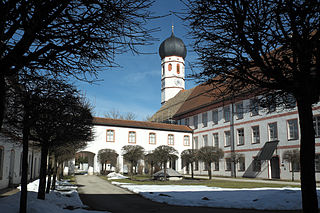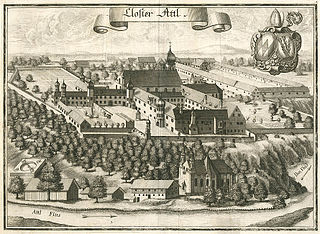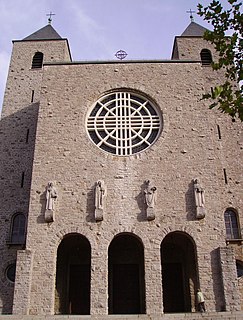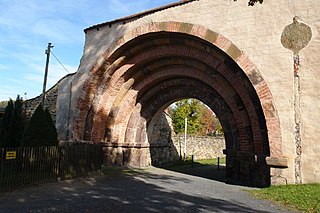



Grafschaft Abbey (German : Kloster Grafschaft) is a community of the Sisters of Mercy of Saint Charles Borromeo, formerly a Benedictine monastery, in Schmallenberg-Grafschaft in the Sauerland, North Rhine-Westphalia, Germany.




Grafschaft Abbey (German : Kloster Grafschaft) is a community of the Sisters of Mercy of Saint Charles Borromeo, formerly a Benedictine monastery, in Schmallenberg-Grafschaft in the Sauerland, North Rhine-Westphalia, Germany.
The Benedictine monastery was founded in 1072 on a site at the foot of the Wilzenberg mountain, by Saint Anno, Archbishop of Cologne, [1] whose statue still stands at the west gate. The monastery was dedicated between 1079 and 1089. The original buildings burned down in 1270. From 1729 the premises were gradually replaced by completely new buildings in the Baroque style; [2] the rebuild was finished in 1742 and the new abbey church dedicated in 1747.
The abbey was dissolved in 1804 as a consequence of secularisation. In 1827 the premises were bought by the Princes von Fürstenberg, but by that time the church was in such a bad condition that it had to be demolished, despite its high architectural quality.
In 1947 the buildings were given to the Sisters of Mercy of Saint Charles Borromeo, who had been expelled from the order's former mother house Trebnitz Abbey, in Silesia. Grafschaft is now the mother house. This is a nursing order, and a large part of the premises is now used as a hospital. [3] There is also a museum of the abbey's history.

Metten Abbey, or St. Michael's Abbey at Metten is a house of the Benedictine Order in Metten near Deggendorf, situated between the fringes of the Bavarian Forest and the valley of the Danube, in Bavaria in Germany.

St. Ludger's Abbey was a former monastery of the Benedictine Order in Helmstedt, Lower Saxony, founded by Saint Ludger around 800. Until it was secularised in 1802 it was an Imperial Abbey, with sovereignty over the whole town of Helmstedt until the 15th century.

Benediktbeuern Abbey is a monastery of the Salesians of Don Bosco, originally a monastery of the Benedictine Order, in Benediktbeuern in Bavaria, near the Kochelsee, 64 km south-south-west of Munich. It is the home of the Songs from Beuern, i.e., the famous Carmina Burana.

Beuerberg Abbey, formerly a monastery of the Augustinian Canons, is now the Monastery of the Visitation, Beuerberg, a community of the Visitandines in Eurasburg in Bavaria, Germany.

Prüfening Abbey was a Benedictine monastery on the outskirts of Regensburg in Bavaria, Germany. Since the beginning of the 19th century it has also been known as Prüfening Castle. Notably, its extant dedicatory inscription, commemorating the founding of the abbey in 1119, was created by printing and is a unique document of medieval typography.

Attel Abbey, also Attl Abbey, was a Benedictine monastery, later a home for the disabled run by the Brothers Hospitallers, in the village of Attel near Wasserburg am Inn in Bavaria, Germany.

Münsterschwarzach Abbey, is a Benedictine monastery in Germany. It is located at the confluence of the rivers Schwarzach and Main in Bavaria.

Wettenhausen Abbey was an Imperial Abbey of Augustinian Canons until its secularization in 1802-1803. Being one of the 40-odd self-ruling Imperial Abbeys of the Holy Roman Empire, Wettenhaussen Abbey was a virtually independent state. Its abbot had seat and voice in the Imperial Diet, where he sat on the Bench of the Prelates of Swabia. At the time of secularization, the Abbey's territory covered 56 square kilometers and it had about 5,400 subjects.

Disentis Abbey is a Benedictine monastery in the Canton of Graubünden in eastern Switzerland, around which the present town of Disentis grew up.

Fischingen Abbey, now Fischingen Priory, is a Benedictine monastery situated in Fischingen in the Canton of Thurgau, Switzerland, on the upper reaches of the Murg, a tributary of the Thur. It was founded in 1138, dissolved in 1848 and re-founded as a priory in 1977.
Buxheim Charterhouse was formerly a monastery of the Carthusians and is now a monastery of the Salesians. It is situated in Buxheim near Memmingen in Bavaria.

Banz Abbey, now known as Banz Castle, is a former Benedictine monastery, since 1978 a part of the town of Bad Staffelstein north of Bamberg, Bavaria, southern Germany.

St. Mang's Abbey, Füssen or Füssen Abbey was a Benedictine monastery in Füssen in Bavaria, Germany. It was founded in the 9th century, and dissolved during the post-Napoleonic secularisation of Bavaria.

St. Ulrich's and St. Afra's Abbey, Augsburg is a former Benedictine abbey dedicated to Saint Ulrich and Saint Afra in the south of the old city in Augsburg, Bavaria.

Kornelimünster Abbey, also known as Abbey of the Abbot Saint Benedict of Aniane and Pope Cornelius, is a Benedictine monastery that has been integrated since 1972. The abbey is located in Aachen in North Rhine-Westphalia in Germany.

Marchtal Abbey is a former Premonstratensian monastery in Obermarchtal in the Alb-Donau-Kreis, Baden-Württemberg, Germany. The minster church of Saints Peter and Paul, the former abbey church, located on a prominent elevation, still dominates the landscape for miles around.
Nienburg Abbey was a Benedictine monastery in Nienburg in Saxony-Anhalt, Germany.

Drübeck Abbey is a former Benedictine monastery for nuns in Drübeck on the northern edge of the Harz in the German state of Saxony-Anhalt. Today it is a conference venue for the Evangelical Church of the Church Province of Saxony with an educational-theological institute and pastoral centre.

Altzella Abbey, also Altzelle Abbey, is a former Cistercian monastery near Nossen in Saxony, Germany. The former abbey contains the tombs of the Wettin margraves of Meissen from 1190 to 1381.
| Wikimedia Commons has media related to Grafschaft Abbey . |